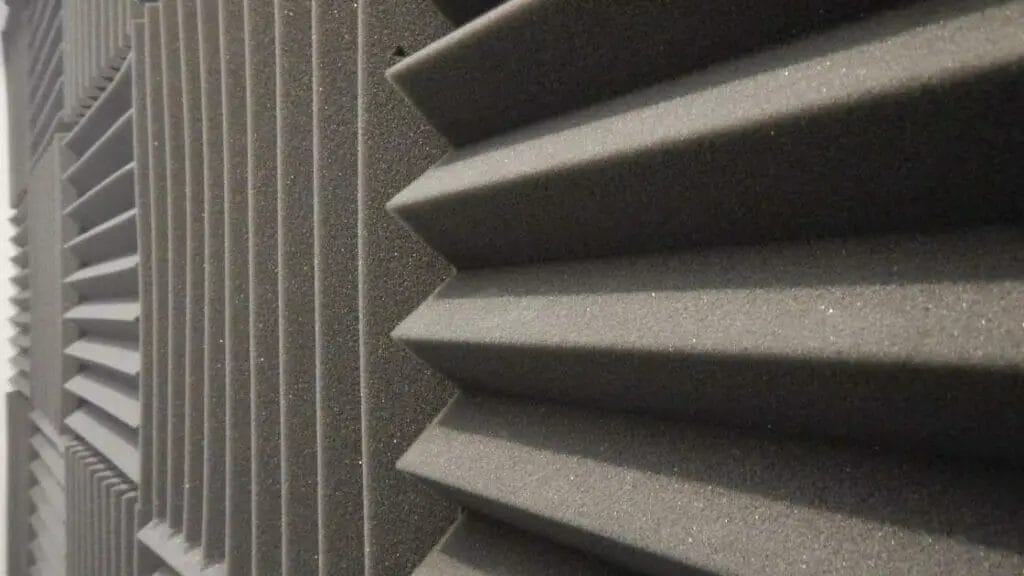Are you building a home theater or a music room and in need of a way to keep the sound in? How about using soundproofing foams like what professional recording artists do? But hold on, how does soundproof foam keep sound in?

Well, a soundproof foam is a remarkable material designed to effectively block, absorb, and dissipate sound waves, creating a quieter environment.
But how does it actually work?
In this article, we will explore the science behind soundproof foam and discover how it keeps sound from escaping or entering a room.
From its unique cellular structure to its ability to disrupt sound waves, soundproof foam is a game-changer when it comes to reducing noise pollution.

The Science Behind Soundproof Foam
To understand how soundproof foam works, it’s important to delve into its scientific properties.
Soundproof foam is typically made from open-cell polyurethane foam, which is known for its excellent sound-absorbing capabilities.
The foam’s cellular structure plays a crucial role in its ability to dampen sound. Each foam cell acts as a miniature sound absorber, trapping sound waves and preventing them from bouncing back into the environment.
Additionally, the open-cell structure allows for the absorption and dissipation of sound energy, effectively reducing echo and reverberation.
When sound waves hit soundproof foam, they enter the foam’s open-cell structure and are immediately met with resistance.
As the sound waves travel through the foam, they encounter numerous air pockets within the cells. These air pockets cause the sound waves to lose energy and become less powerful.
The foam’s ability to absorb and dissipate sound is directly proportional to its thickness and density.
Thicker and denser foam will provide better soundproofing results.
How Soundproof Foam Works
Soundproof foam works by disrupting the transmission of sound waves.
When sound waves hit a solid surface, such as a wall or ceiling, they can easily travel through the material and into the adjacent space. This is how noise pollution occurs.
Soundproof foam, on the other hand, prevents sound waves from traveling through it by absorbing them and converting their energy into heat. This process is known as sound absorption.
The absorption of sound waves occurs due to the unique properties of the foam’s cellular structure.
As sound waves enter the foam, they encounter the open-cell structure, which is designed to trap and dissipate the energy of the waves.
The sound waves get “caught” in the foam’s cells, where they lose energy and are eventually converted into heat.
This absorption process effectively reduces the intensity and volume of the sound waves, resulting in a quieter environment.
Benefits of Using Soundproof Foam
The use of soundproof foam offers numerous benefits, making it a popular choice for soundproofing applications. One of the main advantages of soundproof foam is its ability to significantly reduce noise levels.
Whether you’re trying to create a peaceful workspace, improve sound quality in a recording studio, or block out external noises in a residential setting, soundproof foam can make a noticeable difference.
In addition to noise reduction, soundproof foam also helps to improve the overall acoustics of a room. By absorbing sound waves and reducing echo and reverberation, the foam creates a more balanced and pleasant listening environment.
This is especially beneficial in spaces where sound quality is crucial, such as music studios, theaters, and conference rooms.
Another advantage of soundproof foam is its versatility. It can be easily cut and shaped to fit any space, making it suitable for various applications.
Whether you need to cover an entire wall or simply line the inside of a door, soundproof foam can be customized to meet your specific needs.
Different Types of Soundproof Foam
Soundproof foam is available in various types, each with its own unique properties and applications. The most common types of soundproof foam include:
- Acoustic Foam Panels: These are the traditional soundproof foam panels that come in a range of sizes and thicknesses. They are commonly used in recording studios, home theaters, and offices to reduce echo and reverberation.
- Bass Traps: Bass traps are specifically designed to absorb low-frequency sound waves. They are often placed in corners and near walls to control bass resonance and improve overall sound quality.
- Egg Crate Foam: Egg crate foam, as the name suggests, has a distinctive egg crate-like shape. It is primarily used for soundproofing purposes in areas where aesthetics are not a priority, such as utility rooms and mechanical spaces.
- Noise-Blocking Curtains: These are curtains that are lined with soundproof foam to block out external noises. They are commonly used in bedrooms, home theaters, and offices.
- Soundproofing Panels: Soundproofing panels are a more advanced form of soundproof foam. They are designed to not only absorb sound but also block sound transmission. These panels are typically used in commercial buildings, recording studios, and industrial settings.
Installing Soundproof Foam in Different Areas
The installation of soundproof foam will vary depending on the specific area and application. Here are some general guidelines for installing soundproof foam in different areas:
Walls
To soundproof walls, soundproof foam panels can directly adhere to the surface using a suitable adhesive.
It is important to cover as much surface area as possible to achieve optimal soundproofing results. In some cases, soundproofing panels may be a better option if the sound transmission needs to be blocked.
Ceilings
For soundproofing ceilings, acoustic foam panels or soundproofing panels can be suspended from the ceiling using hooks or adhesive strips.
This helps to reduce sound reflection and improve overall acoustics.
Doors
Soundproof foam can be attached to the inside of doors using adhesive or magnetic strips.
It is important to ensure that the foam covers the entire surface of the door to effectively block sound transmission.
Windows
Soundproofing windows can be a bit more challenging, as windows are a common source of noise infiltration.
One option is to use soundproofing curtains that are lined with soundproof foam. Another option is to install soundproofing window inserts, which create an additional barrier against noise.

Soundproof Foam vs. Other Soundproofing Methods
While soundproof foam is an effective soundproofing solution, it is important to note that it is not the only option available.
There are other soundproofing methods that can be used in conjunction with or as an alternative to soundproof foam.
Some common soundproofing methods include:
- Mass-Loaded Vinyl: Mass-loaded vinyl (MLV) is a dense material that is used to block sound transmission. It can be installed on walls, ceilings, and floors to create a barrier against noise.
- Double Glazing: Double glazing involves installing a second layer of glass in windows to improve sound insulation. The air gap between the two glass layers helps to reduce noise transmission.
- Wall Insulation: Proper wall insulation can significantly reduce noise transmission. Insulating walls with materials such as fiberglass or cellulose can help to block out external noises.
- Sealing: Sealing gaps and cracks in walls, windows, and doors can help to prevent sound from seeping into or out of a room. Weatherstripping and caulk can be used to seal these areas and improve soundproofing.
The choice between soundproof foam and other soundproofing methods will depend on various factors, including the level of noise, budget, and specific requirements of the space.
Common Misconceptions About Soundproof Foam
There are several misconceptions surrounding soundproof foam that are important to address.
One common misconception is that soundproof foam completely blocks all sound.
While it is true that soundproof foam can significantly reduce noise levels, it does not provide complete sound blocking. It is designed to absorb and dissipate sound waves, but some sound may still pass through.
For optimal soundproofing results, it is recommended to combine soundproof foam with other soundproofing methods.
Another misconception is that soundproof foam is only suitable for recording studios and music spaces.
While soundproof foam is commonly used in these settings, its applications are far-reaching. It can be used in offices, bedrooms, home theaters, and any other space where noise reduction is desired.
Soundproof foam is a versatile solution that can be tailored to fit various environments.
Soundproof Foam Maintenance and Care
Proper maintenance and care of soundproof foam are essential for its longevity and effectiveness. Here are some tips for maintaining and caring for soundproof foam:
- Regular Cleaning: Soundproof foam can accumulate dust and dirt over time, which can affect its performance. Regularly vacuuming or dusting the foam will help to keep it clean and maintain its soundproofing properties.
- Avoid Moisture: Soundproof foam should be kept away from moisture, as it can damage the foam and reduce its effectiveness. If the foam gets wet, it should be thoroughly dried before use.
- Inspect for Damage: Periodically inspect the soundproof foam for any signs of damage, such as tears or crumbling. The damaged foam should be replaced to ensure optimal soundproofing results.
- Follow Manufacturer’s Instructions: Different types of soundproof foam may have specific care instructions. It is important to follow the manufacturer’s guidelines for cleaning, maintenance, and installation to maximize the foam’s performance.
Soundproof Foam Products and Where to Buy Them
Soundproof foam products can be found at various home improvement stores, online retailers, and specialized soundproofing suppliers.
When purchasing soundproof foam, it is important to consider the specific needs of your space and choose the appropriate type and size of the foam.
Some popular brands that offer soundproof foam products include Auralex, Owens Corning, and Foam Factory.
Before making a purchase, it is recommended to read customer reviews and compare prices to ensure you are getting the best quality product for your budget.
Additionally, consulting with a soundproofing professional can help you determine the most suitable soundproof foam products for your specific requirements.
